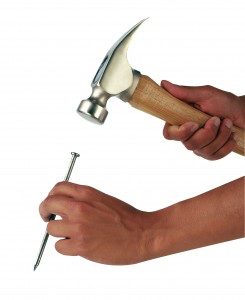Learning the Mandolin:
Repetitive Exercises
By Jean Comeau
Sing along with me: A B C D E F G H I J K L M N O P….
The use of drill exercises to learn languages, to memorize mathematical tables or formulas, to develop a craft or specific skills in sport or music seems inevitable. On the other hand, after many researches on the learning process, we now know very well that such a practice is highly questionable. Drilling might be very useful for some types of learning but, in many other circumstances, it can be a waste of time if not downright harmful.
To learn a new language, drill exercises are used more and more scarcely. The modern language learning tutors will preferably use word-image associations or linguistic structures development. Stuttering math tables or formulas doesn't guarantee a proper understanding. Repeating a motion time after time to get ready for a sport, art or craft usually results in fatigue, pain and injuries.
For the sharps, it's: F C G D A E B; and for the flats...
Despite that fact, these exercises seem to still be well-liked in music. The scales that we repeat ad nauseam, the torture of fingers that we impose ourselves, the melodic patterns that we repeat over and over, are they really worth the trouble? Let's look at results, just to check.
Let's take the example of the tremolo on the mandolin, one of the most important techniques, at least for the repertoire of the Romantic era. If we take a look at the tutor books published since the middle of the nineteenth century, we see that the majority of composers propose to begin tremolo on one note only, then playing scales in tremolo, then short slow melodies that become faster and faster as we turn the pages. From a methodological point of view, it's the same as a verb we conjugate at every tenses of every mood, or those vocabulary lists we spell. We're believing naïvely that we will be able, as if by the shear magic of repetition, to incorporate it into our day to day practice. But will we?
It works but, not all the time.
Drill exercises are not ineffective but a surprise awaits us. Let's take this lovely piece by Alison Stephens: Polly's Variations. It begins with an eight bars theme; then a first variation, like the theme itself, is made of eighth and quarter notes. In the first two parts of the piece, there is no tremolo. For the second variation, we go from a 4/4 measure to 3/4 and we have to play this pattern:
It's not absolutely guaranteed that this C played in tremolo will be at his best, especially if we mainly practiced the technique exclusively with scales and pieces all played in tremolo. The problem comes from the context. We all know that in a musical phrase played in tremolo the two notes that can cause problems are the first and the last one. We might be very skillful at playing tremolo but starting and stopping the tremolo must be practiced as a distinct technique. A few modern composers were smart enough to offer us special exercises on the issue. (See the Mandolin Companion, p. 50)
What do we mean by "practicing in context"
The mistake we make way too often in learning is to believe that if we keep on hitting on the same nail over and over it will improve our skill to remove that same nail when needed. When the context changes, our gains are worthless. It's not because I'm highly skillful in sight-reading that I'll be efficient in music-dictation.
When we play a musical phrase in alternate picking, the trap is always when we change string: playing down—up—down—up—down is something that we must master; playing down—up—down—up—down—changing string—??? requires thinking and the mastering of yet an another skill. The ideal exercise would stress the importance of practicing a specific technique while forcing the performer to play it in different contexts.
And, what's the solution?
So, it's not particularly wise to practice the different techniques using only drill exercises. Fortunately, a few composers, who are usually remarkable teachers, wrote pieces in which every specific technique is presented in as many contexts as possible. Among them, Marlo Strauß and Alison Stephens are offering mandolin learners remarkable pieces.
Alison Stephens Mandolin Trilogy
www.astute-music.com
www.astute-music.com
www.astute-music.com
Alison Stephens' trilogy, Six Episodes, Six Excursions, Six Adventures, published at Astute Music (available in printed version or pdf) remains a model for the elaboration of learning tools. Alison Stephens composed 18 solos for the mandolin, all of them exquisite pieces, in a large variety of styles, that can very well be used as concert pieces. The cool part is that each piece addresses a specific technique but places it in context. We find two voiced melodies with accompaniment, multi-voiced pieces, pieces in the second and third position, arpeggio techniques, pieces using double stops and chords, harmonics, ornaments, and, of course, the star of romantic technique, duo-style.
And, for the final word...
Working "in context" doesn't mean we can get rid of those drill exercises once and for all! But the main advantage of working in context is that it allows us to evaluate our own skill when it comes to specific techniques and to do it in "real pieces". Drill exercises remain artificial.
We rarely have to play pieces like the Prelude no. 2 from Marlo Strauß (Sechs Präludien) in which we must repeat 259 times the same pattern, changing only the colors and the dynamics, stressing the basses and lightening the high notes and all that, of course, Allegro! For such a piece, we must work with drill, work "in context" and probably a whole lot more!
Jean Comeau for Mando Montréal
Jean Comeau studied piano in his childhood and was addicted to Chopin's concertos. He also studied serial composition, flute, organ and singing. During his career as a french and theater teacher in high school, he founded the Bateleur's theater company for which he has written, composed music, made costumes and builds sets for 17 years. Now retired from teaching, Jean devotes himself full time to his passion: the mandolin








